Littelfuse Fuseology
投稿人:DigiKey
Updated 2024-11-01 | Published 2015-12-31
A fuse is a temperature-sensitive device that serves as an intentional weak link in an electrical circuit (Figure 1). It interrupts a circuit when an over-current condition, such as an overload or short-circuit, occurs. The over-current condition causes the fuse metallic element to melt, thereby opening the circuit and protecting downstream circuits. An overload is an over-current event which is confined to normal current paths. An overload occurs when the current exceeds the value for which the wires or equipment are rated. This can happen when too many devices are connected to the circuit, or when a device connected to the circuit malfunctions in a way that causes it to draw higher than normal current, usually in the range of one to six times normal current. Sustained overloads eventually overheat circuit components. Therefore, fuses must open circuits experiencing sustained overloads before damage occurs.
A short-circuit event occurs when current flows out of its normal path. It occurs when an accident or malfunction creates an unintended path for the electricity to flow from the power source to ground. This shorter, more direct path to ground bypasses the resistance normally offered by the wiring and devices connected to the circuit. With virtually no resistance left to impede current flow, the voltage forces higher and higher current to flow through the wires to the point of the short-circuit. Under such a condition, the current will quickly build to such a high level that the heat generated can cause insulation to burn and equipment to be damaged unless the circuit is opened through the use of a fuse.

Figure 1: The purpose of a fuse in an electrical circuit.
As illustrated in Figure 2, a fuse consists of a fusing element, a housing or a fuse body, and terminations. Fuses may be constructed in a variety of ways but they all have these key building blocks.
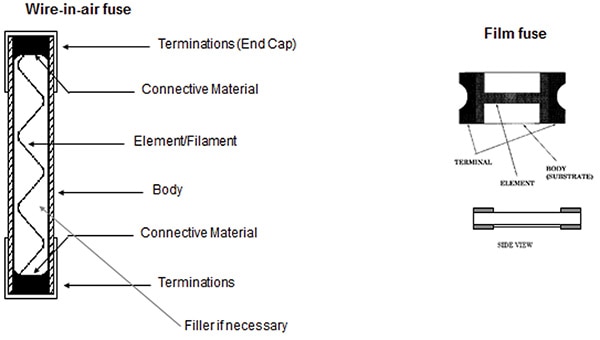
Figure 2: Fuse construction example.
There are several events that take place within a fuse during an abnormal overcurrent event (Figure 3). The fuse element begins as a solid material, and as an overcurrent event occurs, the element begins to melt. If the overcurrent event contains enough energy within a sufficient amount of time, the element will melt to the point where separation begins. As the separation of the element occurs, arcing will begin and will cause further burn-back of the fuse element. The arcing continues until the arc no longer can sustain itself and is extinguished, resulting in a safe, permanent opening of the fuse.
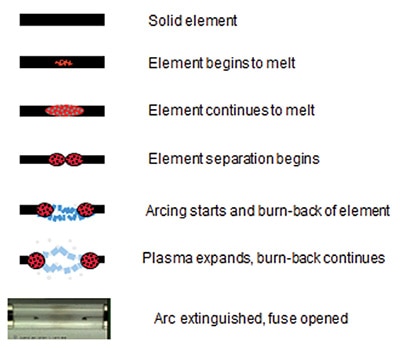
Figure 3: Example of an abnormal current event.
There are four main electrical characteristics that describe a fuse:
- The voltage rating of a fuse is the maximum system voltage for which the fuse can be used safely to open a circuit.
- The current rating of a fuse is the nominal amperage value assigned to the fuse, typically established based on a controlled set of test conditions. This is the value of current a fuse can carry during normal operating conditions.
- The interrupting rating, or breaking capacity, is the maximum specified current which the fuse can safely break at the rated voltage. It should be noted that a fuse can have multiple interrupting ratings as well as both AC and DC ratings.
- The amount of energy needed to begin melting the fuse element is known as melting I2t. With regard to fuses, the term is usually expressed as melting, arcing, and total clearing I2t. The units for I2t are expressed in ampere-squared-seconds [A2s]. I2t has two important applications to fuse selection. This characteristic is often used to determine a fuse’s ability to withstand pulse or transient overcurrent events. It is also used to perform selective coordination with other components in a circuit.
When considering a fuse’s ability to withstand transient overcurrent events without having undesired opening, or “nuisance tripping,” it is important to understand the nature of the transient events and the energy it contains. Based on the expected characteristics of the transient events, each transient pulse will have an associated energy or I2t value (Figure 4). For a fuse to be able to withstand this transient energy repeatedly without opening, it must have a melting I2t that is higher than the I2t value of the transient pulse.
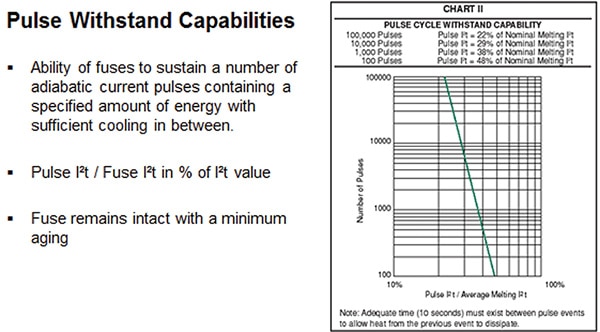
Figure 4: Transient pulse.
Electrical pulses produce thermal cycling and possible mechanical fatigue that could affect the life of the fuse. For this reason, it is important to know the pulse cycle withstand capability (Figure 5) of the fuse, which is defined as the number of pulses of a given I2t value that can be withstood by the fuse without opening, assuming that there is sufficient cooldown time between pulses.

Figure 5: Pulse withstand capabilities.
A fuse’s time-current characteristics determine how fast it responds to different overcurrents. All fuses have inverse time-current characteristics, so opening time decreases as overcurrents increase. Time-current characteristics are presented graphically on standardized “log-log” scales. Time-current (TC) curves, like the one shown in Figure 6, are calibrated time-to-open vs. current curves for a fuse so that a circuit designer can determine how fast the fuse will open under a very specific current condition.
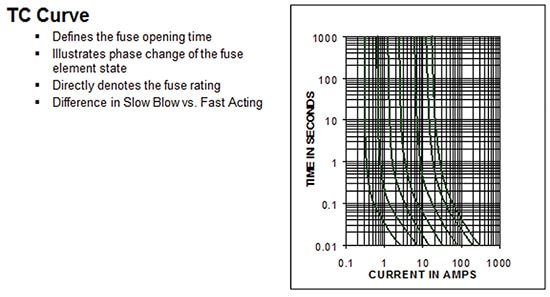
Figure 6: TC curve example.
The current carrying capacity tests of fuses are performed at 25˚C and will be affected by changes in ambient temperature. At higher ambient temperatures, a fuse will respond faster to a given overcurrent condition. Conversely, at lower ambient temperatures, a fuse will respond slower to a given overcurrent condition. In addition, the temperature of the fuse increases as the current carried by the fuse approaches or exceeds the rating of the fuse. Different fuses will have different re-rating curves (like the one shown in Figure 7) based on the construction. Some fuses have minimal changes in fuse rating over a wide temperature range, whereas others have significant changes over a given temperature range.
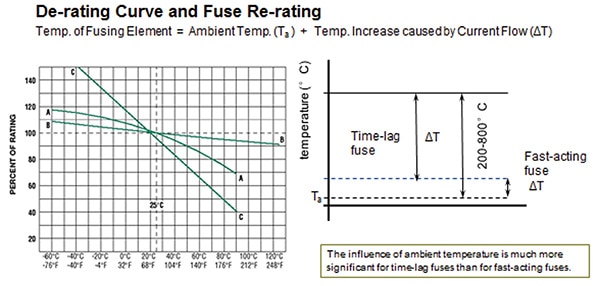
Figure 7: De-rating curve and fuse re-rating example.
In summary, fuses are instrumental circuit protection devices designed to serve as overcurrent protectors in a circuit. As the weakest link in a circuit, a fuse is designed to open a circuit to protect against the threats of abnormal overcurrent events. Although fuses come in a wide variety of sizes and form-factors, they all contain the same basic building blocks, which are centered around the fuse element. Electrical characteristics that describe a fuse include voltage rating, current rating, interrupting rating or “breaking capacity,” and I2t. Fuses do exhibit thermal characteristics that require re-rating when used at temperatures other than room temperature. For a more in-depth discussion on fuses selection, see Littelfuse’s “Fuseology Selection Guide”.
References:
- For a full audio version of this training please visit: Littelfuse/Fuseology PTM

免责声明:各个作者和/或论坛参与者在本网站发表的观点、看法和意见不代表 DigiKey 的观点、看法和意见,也不代表 DigiKey 官方政策。



